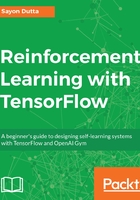
上QQ阅读APP看书,第一时间看更新
Q-Learning
Now, let's try to program a reinforcement learning agent using Q-learning. Q-learning consists of a Q-table that contains Q-values for each state-action pair. The number of rows in the table is equal to the number of states in the environment and the number of columns equals the number of actions. Since the number of states is 16 and the number of actions is 4, the Q-table for this environment consists of 16 rows and 4 columns. The code for it is given here:
print("Number of actions : ",env.action_space.n)
print("Number of states : ",env.observation_space.n)
----------------------
Number of actions : 4
Number of states : 16
The steps involved in Q-learning are as follows:
- Initialize the Q-table with zeros (eventually, updating will happen with a reward received for each action taken during learning).
- Updating of a Q value for a state-action pair, that is, Q(s, a) is given by:

In this formula:
-
- s = current state
- a = action taken (choosing new action through epsilon-greedy approach)
- s' = resulted new state
- a' = action for the new state
- r = reward received for the action a
 = learning rate, that is, the rate at which the learning of the agent converges towards minimized error
= learning rate, that is, the rate at which the learning of the agent converges towards minimized error = discount factor, that is, discounts the future reward to get an idea of how important that future reward is with regards to the current reward
= discount factor, that is, discounts the future reward to get an idea of how important that future reward is with regards to the current reward
- By updating the Q-values as per the formula mentioned in step 2, the table converges to obtain accurate values for an action in a given state.